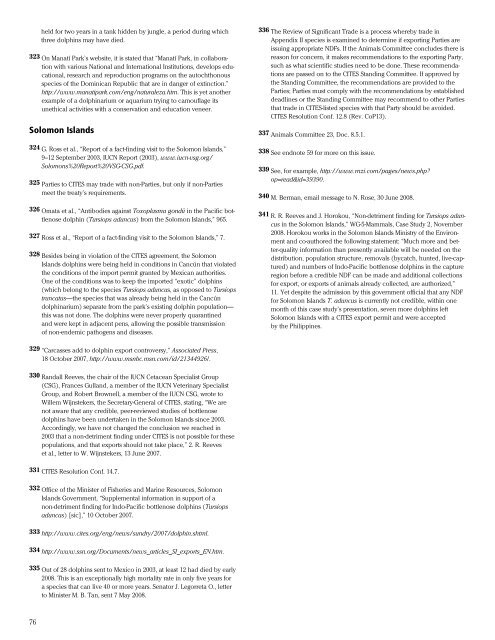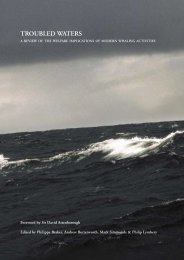United States, as other countries do not require <strong>in</strong>ventories), mediareports, and <strong>in</strong>formation submitted by animal protection activistsaround the world. <strong>The</strong> list is almost certa<strong>in</strong>ly <strong>in</strong>complete regard<strong>in</strong>gpregnancies, unborn fetuses, spontaneous abortions (miscarriages),and stillbirths, mak<strong>in</strong>g the calculated calf survival rate generous. A particularlyunlucky female, Corky II at SeaWorld San Diego, has had atleast seven unsuccessful pregnancies. Twelve of the viable calves arenow dead (aged two to 15 years at death), leav<strong>in</strong>g 28 liv<strong>in</strong>g captivebornorcas at the time of this edition’s publication, the eldest 23 yearsof age, but more than half of them less than 10 years old.304 On average, it is estimated that 43 percent of orca calves <strong>in</strong> the wilddie dur<strong>in</strong>g the first six months of life. Ford, “Killer whale, Orc<strong>in</strong>us orca.”305 Clubb and Mason, “<strong>Captivity</strong> effects on wide-rang<strong>in</strong>g carnivores.”306 Woodley et al., “A comparison of survival rates.”307 R. E. A. Stewart et al., “Bomb radiocarbon dat<strong>in</strong>g calibrates beluga(Delph<strong>in</strong>apterus leucas) age estimates,” Canadian Journal of Zoology84 (2006): 1840–1852; C. Lockyer et al., “Age determ<strong>in</strong>ation <strong>in</strong> belugas(Delph<strong>in</strong>apterus leucas): A quest for validation of dent<strong>in</strong>al layer<strong>in</strong>g,”Aquatic <strong>Mammals</strong> 33 (2007): 293–304.308 See http://www.seaworld.org/animal-<strong>in</strong>fo/<strong>in</strong>fo-books/beluga/longevity.htm for the outdated <strong>in</strong>formation on this topic available fromSeaWorld’s website. This “educational” <strong>in</strong>formation may accuratelyreflect SeaWorld’s experience with its captive belugas, but it doesnot accurately reflect the latest scientific research.309 NMFS, <strong>The</strong> <strong>Mar<strong>in</strong>e</strong> Mammal Inventory Report.Other Cetacean Species310 NMFS, <strong>The</strong> <strong>Mar<strong>in</strong>e</strong> Mammal Inventory Report; Couquiaud, “A surveyof the environments of cetaceans <strong>in</strong> human care,” 299–305.Conclusion311 Reeves and Mead, “<strong>Mar<strong>in</strong>e</strong> mammals <strong>in</strong> captivity.”CHAPTER 10: CONCLUSION312 Closures: Pittsburgh Zoo (dolph<strong>in</strong> exhibit only closed), Oklahoma CityZoo (dolph<strong>in</strong> exhibit only closed), Cedar Fair <strong>in</strong> Ohio (dolph<strong>in</strong> exhibitonly closed), Ste<strong>in</strong>hart Aquarium <strong>in</strong> California (dolph<strong>in</strong> exhibit onlyclosed), Six Flags <strong>in</strong> Ohio (acquired by Cedar Fair, dolph<strong>in</strong> and orcaexhibits only closed), Worlds of Fun <strong>in</strong> Missouri (seasonal dolph<strong>in</strong>show discont<strong>in</strong>ued), Knots Berry Farm <strong>in</strong> California (seasonal dolph<strong>in</strong>show discont<strong>in</strong>ued), Paramount Great America <strong>in</strong> California (seasonaldolph<strong>in</strong> show discont<strong>in</strong>ued), Six Flags Over Texas (seasonal dolph<strong>in</strong>show discont<strong>in</strong>ued), Six Flags <strong>in</strong> Missouri (seasonal dolph<strong>in</strong> show discont<strong>in</strong>ued),Ocean World <strong>in</strong> Florida (entire attraction closed), <strong>Mar<strong>in</strong>e</strong>Life Aquarium <strong>in</strong> South Dakota (entire attraction closed), and <strong>Mar<strong>in</strong>e</strong>Life Oceanarium <strong>in</strong> Mississippi (entire attraction destroyed byHurricane Katr<strong>in</strong>a). Open<strong>in</strong>gs: Dolph<strong>in</strong> Connection <strong>in</strong> Florida (newattraction), Discovery Cove (separate SeaWorld Orlando attraction),the Texas State Aquarium (new exhibit), and the Georgia Aquarium(new attraction). Other dolph<strong>in</strong>aria, amusement parks, and aquariahave expanded or contracted already exist<strong>in</strong>g mar<strong>in</strong>e mammalexhibits and are not <strong>in</strong>cluded <strong>in</strong> this list.313 South Carol<strong>in</strong>a is the only U.S. state to prohibit the public displayof cetaceans.314 J. C. Hillhouse, “ABITPC await<strong>in</strong>g day <strong>in</strong> court,” <strong>The</strong> Daily Observer(Antigua), 21 February 2004.315 <strong>The</strong>se <strong>in</strong>clude the city of Vodnjan, Croatia; the city of Virg<strong>in</strong>ia Beach,Virg<strong>in</strong>ia, USA; the city of Denver, Colorado, USA; and the city ofCalgary, Alberta, Canada. <strong>The</strong> government of Panama, after two yearsof debate and controversy, decided not only <strong>aga<strong>in</strong>st</strong> the build<strong>in</strong>gof a dolph<strong>in</strong>arium, but also <strong>aga<strong>in</strong>st</strong> allow<strong>in</strong>g the capture of dolph<strong>in</strong>sfrom its waters.316 C. Mvula, Animal Attractions Handbook: Travelife—Susta<strong>in</strong>ability<strong>in</strong> Tourism (London: International Tourism Services, 2008),www.its4travel.com.317 <strong>The</strong> only exceptions would be the rescue and rehabilitation of strandedmar<strong>in</strong>e mammals and the ma<strong>in</strong>tenance of animals who cannotbe released.APPENDIX ILa Paz, Mexico318 Diebel, “Trapped <strong>in</strong> an underwater hell, Mexico pressed to freedolph<strong>in</strong>s”; Alaniz and Rojas, Delf<strong>in</strong>arios, 204–205.Bayahibe, Dom<strong>in</strong>ican Republic319 See WSPA, Letter: WSPA Calls on Travel Industry to Pull Supportfor Captive Dolph<strong>in</strong> Program, www.wspa-usa.org/pages/510_letters_manati_park.cfm, 30 November 2001. <strong>The</strong> sudden appearance of theseready-tra<strong>in</strong>ed animals suggests that Manatí Park had another facility<strong>in</strong> the Dom<strong>in</strong>ican Republic that was hold<strong>in</strong>g “spare,” already tra<strong>in</strong>edanimals. As these animals do not appear on any CITES documentation,the assumption is that they were either illegally imported or takenfrom Dom<strong>in</strong>ican waters without proper permitt<strong>in</strong>g prior to the <strong>in</strong>cidentreported here.320 Captures had been prohibited s<strong>in</strong>ce 2000, under Dom<strong>in</strong>ican RepublicEnvironment Law 64–00, article 175. E.C.M. Parsons et al., “A noteon illegal captures of bottlenose dolph<strong>in</strong>s (Tursiops truncatus) <strong>in</strong>the Dom<strong>in</strong>ican Republic,” International Journal of Wildlife Law andPolicy (2009): (<strong>in</strong> press).321 Under Article 11 of the Protocol Concern<strong>in</strong>g Specially Protected Areasand Wildlife (SPAW Protocol) to the Convention for the Protectionand Development of the <strong>Mar<strong>in</strong>e</strong> Environment of the Wider CaribbeanRegion (the Cartagena Convention), it is required that “Each Partyshall ensure total protection and recovery to the species of fauna listed<strong>in</strong> Annex II,” which <strong>in</strong>cludes cetaceans, “by prohibit<strong>in</strong>g: the tak<strong>in</strong>g,possession or kill<strong>in</strong>g (<strong>in</strong>clud<strong>in</strong>g, to the extent possible, the <strong>in</strong>cidentaltak<strong>in</strong>g, possession or kill<strong>in</strong>g) or commercial trade <strong>in</strong> such species,their eggs, parts or products; to the extent possible, the disturbanceof such species, particularly dur<strong>in</strong>g periods of breed<strong>in</strong>g, <strong>in</strong>cubation ormigration, as well as other periods of biological stress.” <strong>The</strong>refore, captur<strong>in</strong>gwild cetaceans for commercial public display is a clear violationof this regional treaty. www.cep.unep.org/pubs/legislation/spaw.html.See also Parsons et al., “A note on illegal captures of bottlenosedolph<strong>in</strong>s (Tursiops truncatus) <strong>in</strong> the Dom<strong>in</strong>ican Republic”.322 In 2004, Manatí Park opened a second facility, Parques Tropicales(Dolph<strong>in</strong> Island–Manatí Park) at Punta Cana. Five dolph<strong>in</strong>s werehoused <strong>in</strong> the new sea pens—there was speculation that these werethe survivors of the eight animals captured <strong>in</strong> August 2002. <strong>The</strong>Dom<strong>in</strong>ican Republic, unlike its neighbor Haiti, is still heavily forestedover much of its territory, and locals believed the dolph<strong>in</strong>s had been75
held for two years <strong>in</strong> a tank hidden by jungle, a period dur<strong>in</strong>g whichthree dolph<strong>in</strong>s may have died.323 On Manatí Park’s website, it is stated that “Manatí Park, <strong>in</strong> collaborationwith various National and International Institutions, develops educational,research and reproduction programs on the autochthonousspecies of the Dom<strong>in</strong>ican Republic that are <strong>in</strong> danger of ext<strong>in</strong>ction.”http://www.manatipark.com/eng/naturaleza.htm. This is yet anotherexample of a dolph<strong>in</strong>arium or aquarium try<strong>in</strong>g to camouflage itsunethical activities with a conservation and education veneer.Solomon Islands324 G. Ross et al., “Report of a fact-f<strong>in</strong>d<strong>in</strong>g visit to the Solomon Islands,”9–12 September 2003, IUCN Report (2003), www.iucn-vsg.org/Solomons%20Report%20VSG-CSG.pdf.325 Parties to CITES may trade with non-Parties, but only if non-Partiesmeet the treaty’s requirements.326 Omata et al., “Antibodies <strong>aga<strong>in</strong>st</strong> Toxoplasma gondii <strong>in</strong> the Pacific bottlenosedolph<strong>in</strong> (Tursiops aduncus) from the Solomon Islands,” 965.327 Ross et al., “Report of a fact-f<strong>in</strong>d<strong>in</strong>g visit to the Solomon Islands,” 7.328 Besides be<strong>in</strong>g <strong>in</strong> violation of the CITES agreement, the SolomonIslands dolph<strong>in</strong>s were be<strong>in</strong>g held <strong>in</strong> conditions <strong>in</strong> Cancún that violatedthe conditions of the import permit granted by Mexican authorities.One of the conditions was to keep the imported “exotic” dolph<strong>in</strong>s(which belong to the species Tursiops aduncus, as opposed to Tursiopstruncatus—the species that was already be<strong>in</strong>g held <strong>in</strong> the Cancúndolph<strong>in</strong>arium) separate from the park’s exist<strong>in</strong>g dolph<strong>in</strong> population—this was not done. <strong>The</strong> dolph<strong>in</strong>s were never properly quarant<strong>in</strong>edand were kept <strong>in</strong> adjacent pens, allow<strong>in</strong>g the possible transmissionof non-endemic pathogens and diseases.336 <strong>The</strong> Review of Significant Trade is a process whereby trade <strong>in</strong>Appendix II species is exam<strong>in</strong>ed to determ<strong>in</strong>e if export<strong>in</strong>g Parties areissu<strong>in</strong>g appropriate NDFs. If the Animals Committee concludes there isreason for concern, it makes recommendations to the export<strong>in</strong>g Party,such as what scientific studies need to be done. <strong>The</strong>se recommendationsare passed on to the CITES Stand<strong>in</strong>g Committee. If approved bythe Stand<strong>in</strong>g Committee, the recommendations are provided to theParties; Parties must comply with the recommendations by establisheddeadl<strong>in</strong>es or the Stand<strong>in</strong>g Committee may recommend to other Partiesthat trade <strong>in</strong> CITES-listed species with that Party should be avoided.CITES Resolution Conf. 12.8 (Rev. CoP13).337 Animals Committee 23, Doc. 8.5.1.338 See endnote 59 for more on this issue.339 See, for example, http://www.rnzi.com/pages/news.php?op=read&id=39390.340 M. Berman, email message to N. Rose, 30 June 2008.341 R. R. Reeves and J. Horokou, “Non-detriment f<strong>in</strong>d<strong>in</strong>g for Tursiops aduncus<strong>in</strong> the Solomon Islands,” WG-5-<strong>Mammals</strong>, <strong>Case</strong> Study 2, November2008. Horokou works <strong>in</strong> the Solomon Islands M<strong>in</strong>istry of the Environmentand co-authored the follow<strong>in</strong>g statement: “Much more and better-quality<strong>in</strong>formation than presently available will be needed on thedistribution, population structure, removals (bycatch, hunted, live-captured)and numbers of Indo-Pacific bottlenose dolph<strong>in</strong>s <strong>in</strong> the captureregion before a credible NDF can be made and additional collectionsfor export, or exports of animals already collected, are authorized,”11. Yet despite the admission by this government official that any NDFfor Solomon Islands T. aduncus is currently not credible, with<strong>in</strong> onemonth of this case study’s presentation, seven more dolph<strong>in</strong>s leftSolomon Islands with a CITES export permit and were acceptedby the Philipp<strong>in</strong>es.329 “Carcasses add to dolph<strong>in</strong> export controversy,” Associated Press,18 October 2007, http://www.msnbc.msn.com/id/21344926/.330 Randall Reeves, the chair of the IUCN Cetacean Specialist Group(CSG), Frances Gulland, a member of the IUCN Veter<strong>in</strong>ary SpecialistGroup, and Robert Brownell, a member of the IUCN CSG, wrote toWillem Wijnstekers, the Secretary-General of CITES, stat<strong>in</strong>g, “We arenot aware that any credible, peer-reviewed studies of bottlenosedolph<strong>in</strong>s have been undertaken <strong>in</strong> the Solomon Islands s<strong>in</strong>ce 2003.Accord<strong>in</strong>gly, we have not changed the conclusion we reached <strong>in</strong>2003 that a non-detriment f<strong>in</strong>d<strong>in</strong>g under CITES is not possible for thesepopulations, and that exports should not take place,” 2. R. Reeveset al., letter to W. Wijnstekers, 13 June 2007.331 CITES Resolution Conf. 14.7.332 Office of the M<strong>in</strong>ister of Fisheries and <strong>Mar<strong>in</strong>e</strong> Resources, SolomonIslands Government, “Supplemental <strong>in</strong>formation <strong>in</strong> support of anon-detriment f<strong>in</strong>d<strong>in</strong>g for Indo-Pacific bottlenose dolph<strong>in</strong>s (Tursiopsaduncas) [sic],” 10 October 2007.333 http://www.cites.org/eng/news/sundry/2007/dolph<strong>in</strong>.shtml.334 http://www.ssn.org/Documents/news_articles_SI_exports_EN.htm.335 Out of 28 dolph<strong>in</strong>s sent to Mexico <strong>in</strong> 2003, at least 12 had died by early2008. This is an exceptionally high mortality rate <strong>in</strong> only five years fora species that can live 40 or more years. Senator J. Legorreta O., letterto M<strong>in</strong>ister M. B. Tan, sent 7 May 2008.76
- Page 1 and 2:
THE CASE AGAINSTMarine Mammalsin Ca
- Page 3 and 4:
Authors: Naomi A. Rose, E.C.M. Pars
- Page 5 and 6:
Public display facilities often pro
- Page 7 and 8:
IntroductionWhen drafting the Marin
- Page 9 and 10:
Education, Conservation, and Resear
- Page 11 and 12:
habitat (known as in situ) or in ca
- Page 13 and 14:
having a well-organized group is cr
- Page 15 and 16:
took advantage of a period of gover
- Page 17 and 18:
Unfortunately, captive facilities r
- Page 19 and 20:
than this one), even when there are
- Page 21 and 22:
Most cutting-edge behavioral resear
- Page 23 and 24:
plans are often wholly inadequate).
- Page 25 and 26:
sanitation methods that kill vegeta
- Page 27 and 28:
A prime example of the inappropriat
- Page 29 and 30: Cetaceans are difficult to diagnose
- Page 31 and 32: allowed to enter the area and dolph
- Page 33 and 34: A detailed survey of public display
- Page 35 and 36: Curaçao. The facility tried to dow
- Page 37 and 38: The irony of the ocean beckoning ju
- Page 39 and 40: This dolphin has been fitted with a
- Page 41 and 42: The very traits that make dolphins
- Page 43 and 44: The behavior of cetaceans also impl
- Page 45 and 46: Most zoos and aquaria currently obt
- Page 47 and 48: Of at least 193 orcas held in capti
- Page 49 and 50: What replaces, with equal impact, p
- Page 51 and 52: only occurs in areas where there is
- Page 53 and 54: sions. This facility had already co
- Page 55 and 56: The Solomon Islands government has
- Page 57 and 58: S. R. Kellert and J. Dunlap, “Inf
- Page 59 and 60: in May 2006). When one considers th
- Page 61 and 62: paper, from 1954, could be found th
- Page 63 and 64: traits (e.g., docile disposition, s
- Page 65 and 66: cial and non-profit sponsors, and s
- Page 67 and 68: D. A. Carder, “Hearing deficits m
- Page 69 and 70: 154 Stereotypies are generally nega
- Page 71 and 72: y J. P. Schroeder entitled “Breed
- Page 73 and 74: Washington Legal Times, stating tha
- Page 75 and 76: about the welfare of the dolphins a
- Page 77 and 78: 251 Small and DeMaster, “Acclimat
- Page 79: Pinnipeds and Other Non-Cetaceans28
















